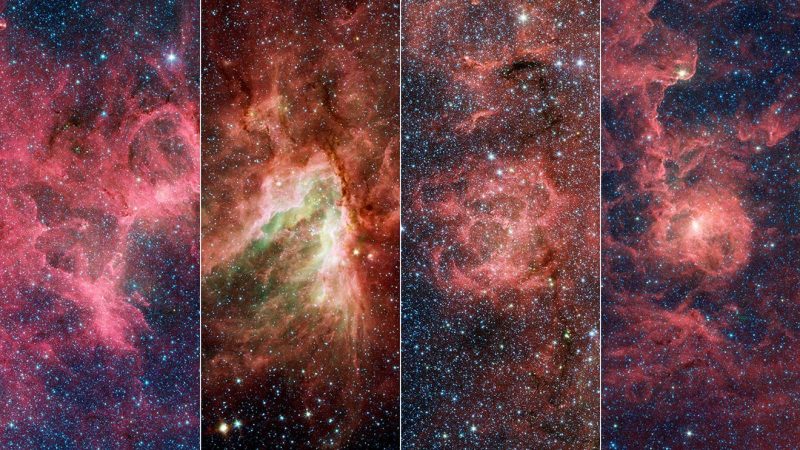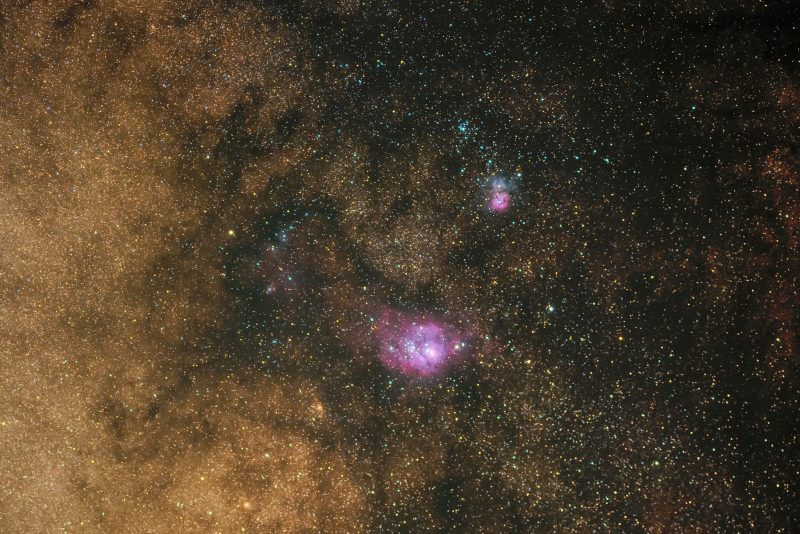
Just as you can’t see the forest for the trees, sometimes you can’t see the galaxy for the stars. Because we’re inside our Milky Way galaxy, we can’t get a complete view of the forest of stars surrounding us. So astronomers around the world this week weren’t surprised to hear of a new discovery. It is that one of our galaxy’s spiral arms – located some 4,000 light-years from Earth – is jutting out at a weird angle. They’re calling it a break in one of the Milky Way’s spiral arms.
This break, extending from the Sagittarius Arm of our Milky Way galaxy, is the first major structure identified with such a dramatic orientation. The scientists published their discovery on July 21, 2021, in the peer-reviewed journal Astronomy and Astrophysics.
Spiral arm break contains famous nebulae

The splintered region of the Sagittarius spiral arm extends for some 3,000 light-years at a sharp angle from the main arm. This region of sky is the region we’re looking toward when we gaze at the constellations Sagittarius and Serpens Cauda and the Milky Way that flows behind these stars. Some of the stars and nebulae located in the spiral arm break are the most famous in the heavens. They include the Eagle Nebula, which is known for the Hubble Space Telescope’s Pillars of Creation photo. And it includes the Omega Nebula, and the Trifid Nebula and Lagoon Nebula. These nebulae are often photographed together.

How scientists found the break
Using data from NASA’s Spitzer Space Telescope, the scientists measured young stars that the telescope’s infrared vision could see hiding within these nebulae. The scientists also used data from ESA’s Gaia mission to measure precise distances to the stars. An author of the study, Alberto Krone-Martins of the University of California, Irvine, said:
Distances are among the most difficult things to measure in astronomy. It is only the recent, direct distance measurements from Gaia that make the geometry of this new structure so apparent.
The combination of the two sets of data revealed that the splintered segment of the Sagittarius Arm contains young stars moving at nearly the same velocity and in the same direction through space. Lead author Michael Kuhn of Caltech said:
When we put the Gaia and Spitzer data together and finally see this detailed, three-dimensional map, we can see that there’s quite a bit of complexity in this region that just hasn’t been apparent before.

Here comes the pitch
The arms of a spiral galaxy are measured in something called a pitch. If a spiral is so tightly wound that it forms a circle, the pitch angle is zero degrees. As the spiral arm opens up, the number denoting the degree of the pitch angle goes up. Kuhn said:
A key property of spiral arms is how tightly they wind around a galaxy. Most models of the Milky Way suggest that the Sagittarius Arm forms a spiral that has a pitch angle of about 12 degrees, but the structure we examined really stands out at an angle of nearly 60 degrees.
Scientists have seen jutting breaks in spiral arms of other galaxies before, but this is the first time such a structure has been identified in our own galaxy.
What caused the Milky Way’s spiral arm break?
Astronomers don’t yet know why the Milky Way, or any galaxy, breaks an arm. But being able to measure the motion of individual stars will help guide them to new understandings. The stars in the spiral arm break likely formed together. Forces within the Milky Way, such as gravity and shear from the galaxy’s spin, likely influenced them. A co-author, Robert Benjamin of the University of Wisconsin-Whitewater, said:
Ultimately, this is a reminder that there are many uncertainties about the large-scale structure of the Milky Way, and we need to look at the details if we want to understand that bigger picture. This structure is a small piece of the Milky Way, but it could tell us something significant about the galaxy as a whole.
Bottom line: Scientists discovered a spiral arm break in our Milky Way galaxy, lying some 4,000 to 7,000 light-years from Earth. This region contains some of the most famous nebulae in the heavens.











